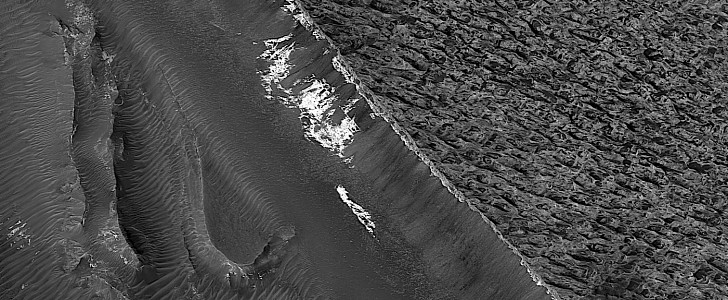Hundreds of years from now, humans might possibly get accustomed to the quirkiness of that little alien planet called Mars. That’s because, by then, we would have hopefully colonized the place, making it into a second home for our species.
That time is however very far into the future, and in the meantime humanity just has to get used to the peculiarities of Mars any way it can. One important path toward that goal is hardware on location, and we have plenty of that there already.
Up in orbit around the planet, a little piece of hardware called Mars Reconnaissance Orbiter spins around the reddish soil, taking countless snapshots of the planet’s surface as it tries to reveal its secrets. And given how Mars presents itself butt naked to the human eye, with no vegetation or water to hide its features, most of the times we’re left with bewildering images of the place.
Kind of like the photo we have here, which shows a portion of the Aureum Chaos region of Mars. It kind of looks like a massive tsunami, washing eastward over uneven terrain, an image we’re all too familiar with given Earth’s tumultuous past.
The thing is that despite looking like one, this is no tsunami. In fact, it’s not even water, because Mars has none in liquid form, at least that we know of. What you’re looking at is the usual Martian terrain, this time arranged in downslope flows and streaks that may or may not be an indication of the region once being home to a body of water.
This image was captured by HiRISE from an altitude of 273 km (169 miles) back in 2015 and was brought back into focus by NASA this year. Although to most of us this is just a pic showing a peculiar feature of Mars, for scientists studying such things it might lead to a better understanding of the seasonality of the streaks.
An understanding that would probably serve us best hundreds of years from now.
Up in orbit around the planet, a little piece of hardware called Mars Reconnaissance Orbiter spins around the reddish soil, taking countless snapshots of the planet’s surface as it tries to reveal its secrets. And given how Mars presents itself butt naked to the human eye, with no vegetation or water to hide its features, most of the times we’re left with bewildering images of the place.
Kind of like the photo we have here, which shows a portion of the Aureum Chaos region of Mars. It kind of looks like a massive tsunami, washing eastward over uneven terrain, an image we’re all too familiar with given Earth’s tumultuous past.
The thing is that despite looking like one, this is no tsunami. In fact, it’s not even water, because Mars has none in liquid form, at least that we know of. What you’re looking at is the usual Martian terrain, this time arranged in downslope flows and streaks that may or may not be an indication of the region once being home to a body of water.
This image was captured by HiRISE from an altitude of 273 km (169 miles) back in 2015 and was brought back into focus by NASA this year. Although to most of us this is just a pic showing a peculiar feature of Mars, for scientists studying such things it might lead to a better understanding of the seasonality of the streaks.
An understanding that would probably serve us best hundreds of years from now.






